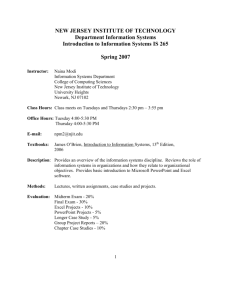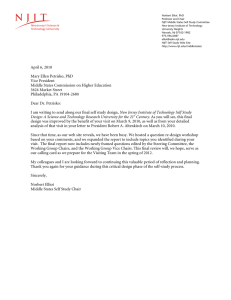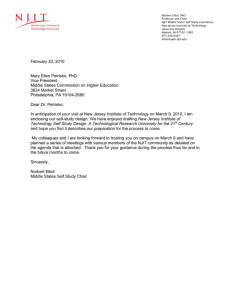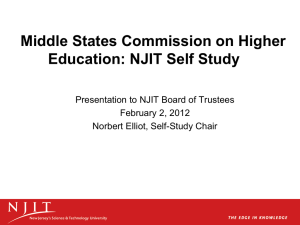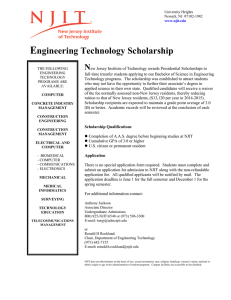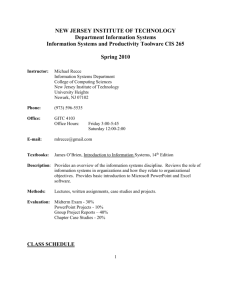T STRATEGIC FOCUS: Sustainable Systems
advertisement
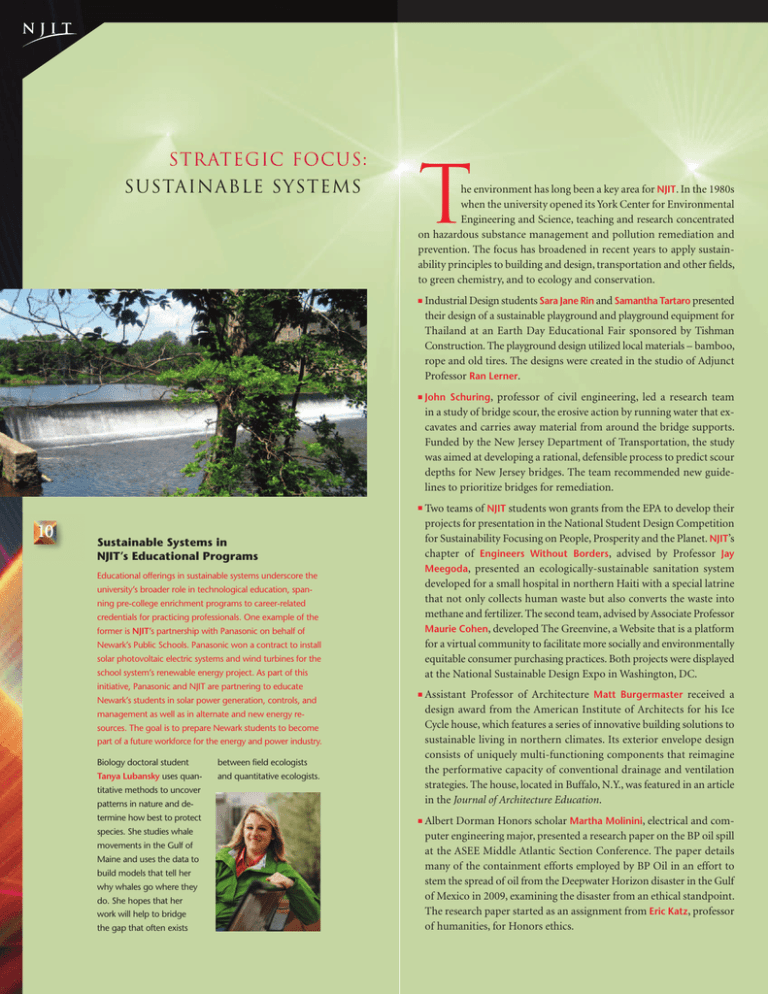
STRATEGIC FOCUS: Sustainable Systems T he environment has long been a key area for NJIT. In the 1980s when the university opened its York Center for Environmental Engineering and Science, teaching and research concentrated on hazardous substance management and pollution remediation and prevention. The focus has broadened in recent years to apply sustainability principles to building and design, transportation and other fields, to green chemistry, and to ecology and conservation. ■ ■ ■ 10 Sustainable Systems in NJIT’s Educational Programs Educational offerings in sustainable systems underscore the university’s broader role in technological education, spanning pre-college enrichment programs to career-related credentials for practicing professionals. One example of the former is NJIT’s partnership with Panasonic on behalf of Newark’s Public Schools. Panasonic won a contract to install solar photovoltaic electric systems and wind turbines for the school system’s renewable energy project. As part of this initiative, Panasonic and NJIT are partnering to educate Newark’s students in solar power generation, controls, and ■ management as well as in alternate and new energy resources. The goal is to prepare Newark students to become part of a future workforce for the energy and power industry. Biology doctoral student between field ecologists Tanya Lubansky uses quan- and quantitative ecologists. titative methods to uncover patterns in nature and determine how best to protect species. She studies whale movements in the Gulf of Maine and uses the data to build models that tell her why whales go where they do. She hopes that her work will help to bridge the gap that often exists ■ Industrial Design students Sara Jane Rin and Samantha Tartaro presented their design of a sustainable playground and playground equipment for Thailand at an Earth Day Educational Fair sponsored by Tishman Construction. The playground design utilized local materials – bamboo, rope and old tires. The designs were created in the studio of Adjunct Professor Ran Lerner. John Schuring, professor of civil engineering, led a research team in a study of bridge scour, the erosive action by running water that excavates and carries away material from around the bridge supports. Funded by the New Jersey Department of Transportation, the study was aimed at developing a rational, defensible process to predict scour depths for New Jersey bridges. The team recommended new guidelines to prioritize bridges for remediation. Two teams of NJIT students won grants from the EPA to develop their projects for presentation in the National Student Design Competition for Sustainability Focusing on People, Prosperity and the Planet. NJIT’s chapter of Engineers Without Borders, advised by Professor Jay Meegoda, presented an ecologically-sustainable sanitation system developed for a small hospital in northern Haiti with a special latrine that not only collects human waste but also converts the waste into methane and fertilizer. The second team, advised by Associate Professor Maurie Cohen, developed The Greenvine, a Website that is a platform for a virtual community to facilitate more socially and environmentally equitable consumer purchasing practices. Both projects were displayed at the National Sustainable Design Expo in Washington, DC. Assistant Professor of Architecture Matt Burgermaster received a design award from the American Institute of Architects for his Ice Cycle house, which features a series of innovative building solutions to sustainable living in northern climates. Its exterior envelope design consists of uniquely multi-functioning components that reimagine the performative capacity of conventional drainage and ventilation strategies. The house, located in Buffalo, N.Y., was featured in an article in the Journal of Architecture Education. Albert Dorman Honors scholar Martha Molinini, electrical and computer engineering major, presented a research paper on the BP oil spill at the ASEE Middle Atlantic Section Conference. The paper details many of the containment efforts employed by BP Oil in an effort to stem the spread of oil from the Deepwater Horizon disaster in the Gulf of Mexico in 2009, examining the disaster from an ethical standpoint. The research paper started as an assignment from Eric Katz, professor of humanities, for Honors ethics. Sustainable Systems in NJIT’s Educational Programs ■ ■ With EPA support, NJIT operates Technical Assistance to Brownfields (TAB), to support and assist communities and nonprofits attempting to clean up and reclaim brownfields. TAB offers advice on site characterization, clean-up technologies, sustainable development, government regulation and community outreach, as well as direct technical mentoring and grant application preparation. Richard Garber, associate professor of architecture, has been named one of 32 new faces of design by Dwell magazine. He shares the honor with Nicole Robertson, his partner in GRO Architects, New York City. The accolade stems from Garber’s body of work, but especially features his newest chef d’oeuvre, “PREttyFAB” house, a one-family sustainable home in the Greenville section of Jersey City. ■ Chemical engineering the production of drinking major Seth Bortey (above water from seawater and left) does research for the saline aquifers. Seth’s NSF Membrane Science, current work focuses on Engineering and Technol- the effects of magnetic ogy Center (MAST) under fields on the precipitation the direction of Professor and flocculation of slightly Boris Khusid (above center). soluble feed salts (calcium The project’s overall goal is carbonate and calcium to study innovative reverse sulfate) to mitigate fouling osmosis (RO) processes for of RO membranes. An internationally recognized expert in membrane separation technologies, Kamalesh Sirkar, distinguished professor of chemical engineering, is now directing the Membrane Science, Engineering and Technology Center, an NSF-funded Industry/University Cooperative Research Center (MAST), in partnership with the University of Colorado, Boulder. Membrane separations offer a wide range of applications in fields such as pharmaceutical manufacturing, water treatment and desalination, and protein purification. He recently published a study with former postdoctoral fellows Li Yang and Atsawin Thongsukmak and partners from General Motors Research and Development in which a hollow fiber membrane was used to remove water from engine oil in an automobile. 11 Daniel Bunker, assistant Sustainable Systems in NJIT’s Educational Programs professor of biology, researches the effects of global environmental change on ecological 12 communities and ecosystems (above left, top photo). Sustainable highperformance buildings are the NJIT students collaborated helping to avoid dramatic with students from Rutgers temperature fluctuations by Evans, director on Team New Jersey to retaining heat in the winter of NJIT’s Center design an energy efficient and keeping the home cool for Building house for the U.S. Depart- in the summer. The NJIT ment of Energy’s Solar Team, advised by Associate Decathlon for 2011. The Professor Richard Garber, team designed and built and led by Jen Switala, eNJoy House, a prototype MArch ’11, included smart home whose design architecture students Brian challenges traditional Darling, Ahmed Emara, Physics building techniques and Jon Gann*, Zachary Hvi- Trevor Tyson, suggests a new method of zlak, Andrew Mailloux*, studies the approaching high perform- Liam Morrow, Jay Piccone, application ance, energy efficient Ian Seigal* and Jordan housing. The eNJoy House Tate; IT students Conrad uses super-insulated pre- Lope and Jason Weiner; cast concrete panels as computer science student solution of the primary construction Kirill Vainer, and Enkela energry and material. The pre-cast Malellari, ’11, civil environmental concrete contributes to the engineering. changes (photo home’s high thermal mass, *Albert Dorman Honors scholar focus of Deane Knowledge (above left, bottom photo). Distinguished Professor of of novel physics and materials science methods to the far right). A team of mechanical and industrial engineers at NJIT is developing analytical tools to help New Jersey businesses implement an eco-efficient and sustainable energy use strategy. With nearly $1 million in funding from the PSE&G Energy Technology Demonstration Grant Program, Professor Reggie J. Caudill (above center) is leading a project to develop a Web-based guide to eco-efficiency and sustainability for New Jersey industry. Collaborating on the project are Professors Sanchoy Das and Paul Ranky (not pictured), and Associate Professor Zhiming Ji. The team will utilize the Sustainability Target Method (STM), a novel approach to measuring sustainability and eco-efficiency of entire businesses, plant operations and individual products. Developed originally at Bell Labs and extended by the research team at NJIT, the STM methodology establishes linkages between the Earth’s carrying capacity, economic value, and environmental impact to provide an absolute or “target” criteria for sustainability that is practical for use by managers and plant engineers. They will also provide simulation and decision support technologies to allow an engineering analysis of energy consumption patterns and process inefficiencies and evaluation of alternative strategies for improvement. The educational and training aspects will utilize interactive multimedia technologies with Web-based and mobile device interfaces to facilitate effective implementation. Research by Sima Bagheri , professor of civil and environmental engineering (below left), focuses on phytoplankton, a class of microscopic organisms that live in both fresh and salt water environments. Frequently the first indicator of a change in their environment, phytoplankton, as revealed by ocean color images, can show scientists where ocean currents NJIT Ne xt ■ S t r at e g i c d i r e c t i o n s ■ 2012 s t r at e g i c F o c u s : s u s ta i n a b l e s y s t e m s provide nutrients for plant growth and where subtle changes in the climate — warmer or colder, more saline or less saline — affect phytoplankton growth. Her long term research, which focuses on the Hudson/ Raritan Estuary of New Jersey and New York off Sandy Hook, NJ, makes use of ocean color data collected by satellites such as NASA’s SeaWIFS and MODIS as well as sensors flown in aircraft as in NASA’s AVIRIS program. A faster, better and cheaper desalination process enhanced by carbon nanotubes has been developed by Somenath Mitra, distinguished professor and chair of chemistry and environmental science (left in photo at left) and his research team, doctoral students Ornthida Sae-Khow (right in photo) and Ken Gethard (not pictured). The process creates a unique new architecture for the membrane distillation process by immobilizing carbon nanotubes in the membrane pores. Conventional approaches to desalination are thermal distillation and reverse osmosis, but these methods are too expensive for many countries and cities that lack potable water. It is hoped that the new technique will help to bring clean water to poor areas. A team lead by Michael Jaffe, Sustainable Systems in the Educational Programs research professor of biomedical engineering (above, top left photo), is developing cost-effective corn based chemistries and processes Distinguished Professor of Physics Trevor Tyson studies the application of novel physics and materials science methods to the solution of energy and environmental challenges. He was part of a team that developed a selfcleaning technique to allow solid oxide fuel cells to be powered directly by coal gas at operating temperatures as low as 750 degrees Celsius using barium oxide nanoparticles. The technique, developed in collaboration with Georgia Institute of Technology, Brookhaven National Laboratory, and Oak Ridge National Laboratory, could provide a cleaner and more efficient alternative to conventional power plants for generating electricity from the nation’s vast coal reserves. The water-mediated carbon removal technique was reported June 21 in the journal Nature Communications. relevant to the commercial polymer industry. Zeyuan Qiu, Ashish Borgaonkar, won second place in the associate doctoral student in envi- 2011 Samuel and Rhoda professor of ronmental engineering Chalfin Memorial Scholar- chemistry and (above), has developed a ship Competition for his environmental new technique for remov- design of the “Lean Green science (above, ing potentially harmful Chair” that is constructed nano-particles from the entirely of cardboard, and water supply. He uses held together through bottom left photo), studies the close land-water magnetic particles to compression without connections. remove the microscopic the use of glue, tape, or With funding residue left behind by staples. Inspired by Gerrit from the U.S. cosmetics and shampoos Thomas Rietveld’s “Berlin Department more efficiently than Chair,” Pashalian’s piece, of Agriculture, conventional treatment methods. Taha Marhaba, professor and chairman of civil and environmental engineering, is his faculty advisor. he helps local agencies develop a riparian restoration plan for agricultural lands in New Jersey’s Interior Design student Tristan Pashalian (right) Raritan River Basin. High-performance, sustainable buildings, particularly housing and schools, are the focus of Deane Evans, director of NJIT’s Center for Building Knowledge. He leads a U.S. Department of Energy (DOE) program to create a comprehensive series of four online courses to train and teach mechanical engineers across the country how to improve the energy efficiency of existing commercial buildings. He is also the NJIT lead in a research and deployment partnership to help dramatically improve the energy efficiency of American homes ─ the Building America Retrofit Alliance (BARA). NJIT is partnering with Building Media Inc. (BMI), a DuPont subsidiary, to establish one of 15 teams appointed by DOE to deliver innovative energy efficiency strategies to the residential market and address barriers to bringing high-efficiency homes within reach of all Americans. Finally, his center is a core member of the Greater Philadelphia Innovation Cluster, a DOE “Innovation Hub” focused on improving the energy efficiency of commercial office buildings in the United States. The research of Assistant Professor of Biology Daniel Bunker is aimed at understanding the effects of global environmental change on ecological communities and ecosystems. In collaboration with Shahid Naeem of Columbia University, he is developing TraitNet, a research coordination network and biological database designed to foster the systematic collection and dissemination of species trait data such as body size and metabolic rate. The goal is to build an ecoinformatics backbone that will enable seamless data contributions to a fully searchable, geo-referenced database. 13 NJIT Ne xt ■ S t r at e g i c d i r e c t io n s ■ 2012 s t r at e g i c F o c u s : s u s ta i n a b l e s y s t e m s STRATEGIC FOCUS: Life and The structural applications of composite and renewable materials are a research interest of Ala Saadeghvaziri, professor of civil and environmental engineering (left), and his graduate student Amin Jamali (right). They have been studying recycled aggregate concrete (RAC), to learn what level of stresses and deformations recycled concrete can withstand under a seismic event. Healthcare Science and Engineering I n just 10 years since its establishment, the Department of Biomedical Engineering has emerged as one of the university’s strongest departments with research programs that are already nationally recognized in such areas as tissue engineering and rehabilitation medicine. The health sciences have become a pervasive theme throughout the university with contributions to research and education in nearly every department: ■ Robert Miura, distinguished professor of mathematics, is leading a research team in a study of cortical spreading depression (CSD), a nonlinear chemical and electrical (slow) wave phenomenon in the cortices of different brain structures known to be connected with migraine with aura, and possibly with stroke and transient global amnesia. ■ 14 They developed a mathematical model for predicting the impact of high levels of stresses and strains on response of the RAC structures, and conducted extensive experimentation with the material in NJIT’s High Performance Concrete Laboratory. Although additional testing is required, they project that RAC may be suitable for structural use. ■ Zeyuan Qiu, associate professor of chemistry and environmen- tal science, studies the close land-water connections. With funding from the U.S. Department of Agriculture, he helps local agencies develop a riparian restoration plan for agricultural lands in New Jersey’s Raritan River Basin. The restoration plan identifies agricultural lands in riparian areas, prioritizes restoration projects, estimates restoration costs, identifies and evaluates available funding sources to complete the riparian restoration projects and also details comprehensive education and outreach activities for farmers and the general public. The development of new or improved synthetic materials from corn derivatives is the goal of a partnership among NJIT researchers and the Iowa Corn Promotion Board. With NSF support and industrial partners, the research team, lead by Michael Jaffe, research professor of biomedical engineering, is developing cost-effective corn based chemistries and processes relevant to the commercial polymer industry. The study focuses on isosorbide, a substance derived from corn sugar that is currently used in pharmaceuticals but could replace other chemicals in the production of plastics. ■ ■ Cheickna Sylla, professor of management, published an article proposing a cost/benefit justification framework for the establishment of a workplace ergonomics program that will reduce the incidence of musculoskeletal disorders. The paper appeared in the International Journal of Networking and Virtual Organization. Carol Venanzi, distinguished professor of chemistry, uses computational chemistry and molecular modeling techniques to analyze the relationship of molecular structure to biological function through computer-aided drug design. In an NIH-supported project, she has been studying salvinorin A, a substance that shows promise both in the treatment of stimulant abuse and for the development of analgesics with a reduced tendency for tolerance and dependence. Her team is working in collaboration with scientists at the National Institutes of Health and the University of Iowa. The research of Ecevit Bilgili, assistant professor of chemical, biological and pharmaceutical engineering, is aimed at enhancing the bioavailability of poorly soluble active pharmaceutical ingredients. Recent projects have employed nano-particle coated pellets and the fluidized bed (FB) technology developed at NJIT’s New Jersey Center for Engineered Particulates. Associate Professor of History Stephen Pemberton studies the 20thcentury history of medicine, biomedical sciences and technology, and the history of public health to understand how social issues intersect with scientific breakthroughs. His most recent book deals with efforts to manage hemophilia and other hereditary bleeding disorders and how those advances eventually devolved into the AIDS crisis. His earlier book, The Troubled Dream of Genetic Medicine: Ethnicity and Innovation in Tay-Sachs, Cystic Fibrosis and Sickle Cell Disease, looks at the role of ethnicity in medical innovation and treatment.

